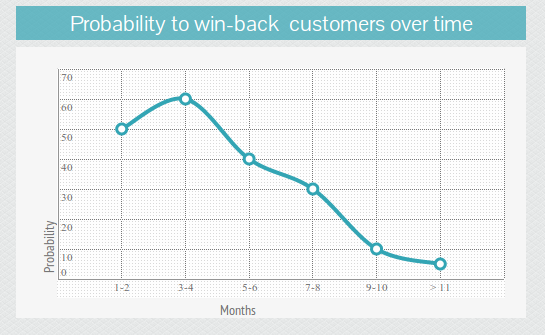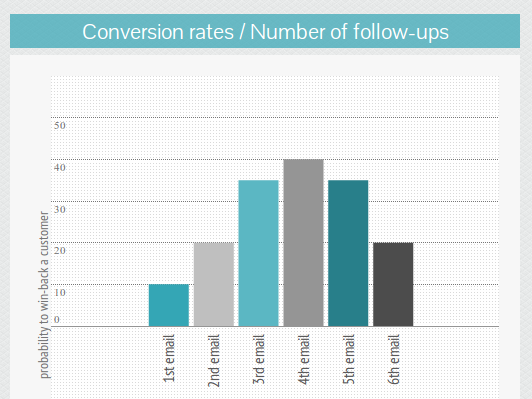How Web Merchants Can Win Back Inactive Customers

Repeat sales are extremely important for any business. Although most retailers focus their marketing efforts on getting new customers, the cost of acquiring a new customer is 6-7 times greater than getting repeat sales from an existing customer. According to Marketing Metrics, the probability of selling to an existing customer is 60-70 percent, while the probability of selling to a new prospect is 5-20 percent. Another advantage, which people tend to forget, is that increasing the lifetime value of a customer increases the amount you can spend on acquisition of new customers. This means you will increase the chances of acquiring new customers. So increasing repeating sales not only brings additional revenue, which is easier to attain (compared to new customers) it also helps in itself get new customers by supporting the economic viability of a larger marketing campaign.
But how can we increase repeated sales? There are many marketing strategies to incentivize and move customers into buying more, from loyalty programs, discounts, promotions and more. Here are five tips to win back inactive customers.
Tip #1 - Identify your inactive customers
This may seem trivial, but, believe me, it's not. Every type of business may have a different characterization of inactive customers. For example, if a consumer of ink cartridges has not purchased another cartridge in the past two months, should he/she be considered an inactive customer? Of course not. Here is a generalization of how to classify inactive customers:
- Consumables - consumables businesses should know the recurring periods for purchases. For example, a pet shop should know that a bag of a certain dog food usually lasts one month. In this case, when a customer that purchases the dog food every month stops purchasing on a certain month or has not purchased for a couple of months, this customer should be considered an inactive customer.
- Seasonal - the fashion market is generally seasonal (summer, fall, winter and spring). So, for example, if a customer bought items from the summer collection and then has not purchased from the fall collection, should he/she be considered an inactive customer? In this case it depends on the approach. If we do not want to push too hard, we may choose to consider as inactive customers those that have "skipped" at least two seasons.
- Other - there are many other examples of how to identify inactive customers. To do it effectively, you need to analyze the purchasing data of your customers and then build a "formula" or "rule" - for example - customers that have purchased more than once and have not purchased during the last 90 days.
Note that although any customer that has purchased before can be considered an inactive customer, for the purpose of applying various marketing tactics, we suggest considering as inactive customers only customers that have purchased more than once. Occasional customers or "one-time" customers have other characteristics that should be addressed differently.
Tip #2 - Time is of the essence
When it comes to winning back inactive customers time is of the essence. The more time passes, the reasons that would bringing back your customers, such as brand loyalty and positive experience, rapidly fade away. Remarkety's statistics show that probability drops by almost 50 percent after five months if you don't take action. After deciding on the formula/rule for identifying inactive customers, you should approach them as soon as they are deemed inactive by sending an email.

Tip #3 - One time may not be enough
Our statistics show that sending one email may not be enough. Many of our users send an email after 60 days of inactivity, then another after 90 days, and so on. Sending multiple emails is important and effective. In fact, in most cases, you should engage with your customer 3-5 times before he/she decides to purchase again.

Tip #4 - How to incentivize inactive customers
Let the customer know that you care about the fact that he/she has not purchased for a long time and offer some kind of incentive like a discount on the next purchase. Our statistics show that as time passes so should the reward become more substantial. After a certain point, take into account that some customers could take advantage of the fact that you give discounts to inactive customers and hold out until they receive one. But this shouldn't prevent you from doing so. One solution is to not be consistent with the discount levels that you send out. Do not give a discount that would eliminate the profitability of the next purchase. You should provide different incentives to different types of customers. For example, VIP customers and steady customers who have spent a lot of money, should receive a preferable treatment.
Tip #5 - Be extremely personal
An email to win back an inactive customer should be very different from a general promotional email or a newsletter. It should address the fact that the customer has not purchased for a long time. Try something like "we have noticed that you haven't...." or "we haven't seen you around for a long time...". If you want to take it to the next level you can even remind the customer of previous purchases and then offer a discount on the same or complementary item. This personal touch goes a long way with consumers and from our statistics we have seen that personal email receive 200 percent more clicks and purchases.
Note that in some cases over personalization can have an opposite effect. For example, try not put the customer name in the subject line. This may deter users and can be mistakenly identified as spam by spam filters.
This blog post was written by Alon Men. Alon is the Online Marketing Executive at Remarkety (www.remarkety.com), a provider of email remarketing solutions for small and medium ecommerce retailers, and the CEO of Writec (www.writec.co.il). Alon has extensive experience in ecommerce, serving as consultant for various ecommerce ventures around the world.







